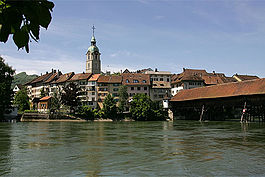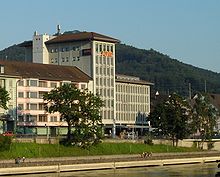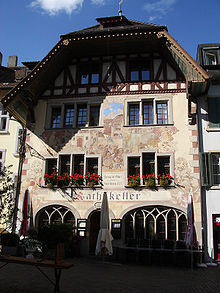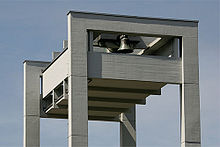- Olten
-
Olten Old town with covered bridge Country Switzerland 
Canton Solothurn District Olten 47°21′N 7°54′E / 47.35°N 7.9°ECoordinates: 47°21′N 7°54′E / 47.35°N 7.9°E Population 17,172 (Dec 2010)[1] - Density 1,495 /km2 (3,871 /sq mi) Area 11.49 km2 (4.44 sq mi) Elevation 396 m (1,299 ft) Postal code 4600 SFOS number 2581 Mayor Ernst Zingg Surrounded by Aarburg (AG), Boningen, Dulliken, Kappel, Rothrist (AG), Starrkirch-Wil, Trimbach, Wangen bei Olten, Winznau Twin towns Altenburg (Germany) Website www.olten.ch
SFSO statisticsView map of Olten Olten is a town in the canton of Solothurn in Switzerland and capital of the district of the same name.
Olten's railway station is within 30 minutes of Zurich, Bern, Basel, and Lucerne by train, and is a rail hub of Switzerland.
Contents
History
Despite the presence of numerous archaeological evidences of early habitation, Olten is first documented in 1201 as Oltun.[2] It became important in the 13th century because of its bridge over the Aar River. This geographical fact has determined much of its history. Mgr.Bruno Bernard Heim was born in Olten.
Geography
Olten has an area, as of 2009[update], of 11.49 square kilometers (4.44 sq mi). Of this area, 1.46 km2 (0.56 sq mi) or 12.7% is used for agricultural purposes, while 4.81 km2 (1.86 sq mi) or 41.9% is forested. Of the rest of the land, 4.65 km2 (1.80 sq mi) or 40.5% is settled (buildings or roads), 0.53 km2 (0.20 sq mi) or 4.6% is either rivers or lakes and 0.06 km2 (15 acres) or 0.5% is unproductive land.[3]
Of the built up area, industrial buildings made up 6.0% of the total area while housing and buildings made up 15.6% and transportation infrastructure made up 11.6%. Power and water infrastructure as well as other special developed areas made up 4.2% of the area while parks, green belts and sports fields made up 3.1%. Out of the forested land, 40.7% of the total land area is heavily forested and 1.1% is covered with orchards or small clusters of trees. Of the agricultural land, 6.2% is used for growing crops and 5.9% is pastures. All the water in the municipality is flowing water.[3]
The old city of the capital of the Olten district is located in a bend of the river between the Aare and Dünnern rivers. In the 19th Century housing estates were built in the valley on both sides of the Aare river between slopes of the Jura Mountains to the north and the Born, Säli und Engelberg mountains to the south.
The municipalities of Hauenstein-Ifenthal, Trimbach, Wisen and Olten are considering a merger at a date in the future into the new municipality of with an, as of 2011[update], undetermined name.[4]
Coat of arms
The blazon of the municipal coat of arms is Argent three Fir Trees Vert trunked Gules issuant from a Mount of 3 Coupeaux of the second.[5]
Demographics
Olten has a population (as of December 2010[update]) of 17,172.[1] As of 2008[update], 27.3% of the population are resident foreign nationals.[6] Over the last 10 years (1999–2009 ) the population has changed at a rate of 1.2%.[7]
Most of the population (as of 2000[update]) speaks German (13,855 or 82.7%), with Italian being second most common (844 or 5.0%) and Albanian being third (356 or 2.1%). There are 167 people who speak French and 22 people who speak Romansh.[8]
As of 2008[update], the gender distribution of the population was 49.5% male and 50.5% female. The population was made up of 18,728 Swiss men (36.5% of the population) and 6,688 (13.0%) non-Swiss men. There were 20,186 Swiss women (39.3%) and 5,772 (11.2%) non-Swiss women.[9] Of the population in the municipality 4,596 or about 27.4% were born in Olten and lived there in 2000. There were 2,920 or 17.4% who were born in the same canton, while 4,585 or 27.4% were born somewhere else in Switzerland, and 3,904 or 23.3% were born outside of Switzerland.[8]
In 2008[update] there were 93 live births to Swiss citizens and 73 births to non-Swiss citizens, and in same time span there were 184 deaths of Swiss citizens and 18 non-Swiss citizen deaths. Ignoring immigration and emigration, the population of Swiss citizens decreased by 91 while the foreign population increased by 55. There were 6 Swiss women who immigrated back to Switzerland. At the same time, there were 82 non-Swiss men and 65 non-Swiss women who immigrated from another country to Switzerland. The total Swiss population change in 2008 (from all sources, including moves across municipal borders) was a decrease of 101 and the non-Swiss population increased by 37 people. This represents a population growth rate of -0.4%.[6]
The age distribution, as of 2000[update], in Olten is; 1,011 children or 6.0% of the population are between 0 and 6 years old and 2,083 teenagers or 12.4% are between 7 and 19. Of the adult population, 956 people or 5.7% of the population are between 20 and 24 years old. 5,271 people or 31.5% are between 25 and 44, and 3,818 people or 22.8% are between 45 and 64. The senior population distribution is 2,497 people or 14.9% of the population are between 65 and 79 years old and there are 1,121 people or 6.7% who are over 80.[10]
[[as of|2000}}, there were 6,700 people who were single and never married in the municipality. There were 7,504 married individuals, 1,356 widows or widowers and 1,197 individuals who are divorced.[8]
As of 2000[update] the average number of residents per living room was 0.54 which is about equal to the cantonal average of 0.56 per room.[7] In this case, a room is defined as space of a housing unit of at least 4 m2 (43 sq ft) as normal bedrooms, dining rooms, living rooms, kitchens and habitable cellars and attics.[11] About 22% of the total households were owner occupied, or in other words did not pay rent (though they may have a mortgage or a rent-to-own agreement).[12]
As of 2000[update], there were 8,069 private households in the municipality, and an average of 2. persons per household.[7] There were 3,535 households that consist of only one person and 325 households with five or more people. Out of a total of 8,221 households that answered this question, 43.0% were households made up of just one person and there were 59 adults who lived with their parents. Of the rest of the households, there are 2,246 married couples without children, 1,683 married couples with children There were 396 single parents with a child or children. There were 150 households that were made up of unrelated people and 152 households that were made up of some sort of institution or another collective housing.[8]
In 2000[update] there were 1,439 single family homes (or 49.2% of the total) out of a total of 2,922 inhabited buildings. There were 933 multi-family buildings (31.9%), along with 304 multi-purpose buildings that were mostly used for housing (10.4%) and 246 other use buildings (commercial or industrial) that also had some housing (8.4%). Of the single family homes 379 were built before 1919, while 73 were built between 1990 and 2000. The greatest number of single family homes (702) were built between 1919 and 1945.[13]
In 2000[update] there were 9,217 apartments in the municipality. The most common apartment size was 3 rooms of which there were 3,158. There were 677 single room apartments and 1,669 apartments with five or more rooms. Of these apartments, a total of 7,928 apartments (86.0% of the total) were permanently occupied, while 820 apartments (8.9%) were seasonally occupied and 469 apartments (5.1%) were empty.[13] As of 2009[update], the construction rate of new housing units was 1 new units per 1000 residents.[7]
As of 2003[update] the average price to rent an average apartment in Olten was 1063.57 Swiss francs (CHF) per month (US$850, £480, €680 approx. exchange rate from 2003). The average rate for a one room apartment was 592.19 CHF (US$470, £270, €380), a two room apartment was about 787.80 CHF (US$630, £350, €500), a three room apartment was about 937.35 CHF (US$750, £420, €600) and a six or more room apartment cost an average of 1694.74 CHF (US$1360, £760, €1080). The average apartment price in Olten was 95.3% of the national average of 1116 CHF.[14] The vacancy rate for the municipality, in 2010[update], was 1.85%.[7]
The historical population is given in the following chart:[2][15]

Heritage sites of national significance
The Old City, which includes a roman era vicus as well as medieval and early modern developments, Train Station, the prehistoric and roman era hilltop settlement of Dickenbännli, the covered wooden bridge over the Aare river and the Naturmuseum are listed as Swiss heritage sites of national significance. The entire town of Olten is part of the Inventory of Swiss Heritage Sites.[16]
Culture
Every year, on August 1, a large firework show occurs from boats floating down the river. It is also home to a wooden foot bridge, one of the towns landmarks. In Olten's railway station restaurant, the Gruppe Olten (Olten Group), a group of writers that included Max Frisch and Friedrich Dürrenmatt, was founded, as was the Swiss Alpine Club in 1863.
Politics
In the 2007 federal election the most popular party was the SP which received 25.31% of the vote. The next three most popular parties were the SVP (21.42%), the FDP (18.61%) and the CVP (15.8%). In the federal election, a total of 5,515 votes were cast, and the voter turnout was 50.9%.[17]
Economy
As of 2010[update], Olten had an unemployment rate of 4.4%. As of 2008[update], there were 19 people employed in the primary economic sector and about 7 businesses involved in this sector. 2,825 people were employed in the secondary sector and there were 147 businesses in this sector. 13,000 people were employed in the tertiary sector, with 1,067 businesses in this sector.[7] There were 8,299 residents of the municipality who were employed in some capacity, of which females made up 43.8% of the workforce.
In 2008[update] the total number of full-time equivalent jobs was 13,275. The number of jobs in the primary sector was 14, of which 8 were in agriculture and 6 were in forestry or lumber production. The number of jobs in the secondary sector was 2,700 of which 1,465 or (54.3%) were in manufacturing and 976 (36.1%) were in construction. The number of jobs in the tertiary sector was 10,561. In the tertiary sector; 1,486 or 14.1% were in the sale or repair of motor vehicles, 1,882 or 17.8% were in the movement and storage of goods, 577 or 5.5% were in a hotel or restaurant, 977 or 9.3% were in the information industry, 1,204 or 11.4% were the insurance or financial industry, 1,058 or 10.0% were technical professionals or scientists, 785 or 7.4% were in education and 1,356 or 12.8% were in health care.[18]
In 2000[update], there were 11,508 workers who commuted into the municipality and 4,156 workers who commuted away. The municipality is a net importer of workers, with about 2.8 workers entering the municipality for every one leaving.[19] Of the working population, 28.4% used public transportation to get to work, and 37.6% used a private car.[7]
The headquarters of SBB Cargo International is in Olten.
Religion
From the 2000 census[update], 6,803 or 40.6% were Roman Catholic, while 4,262 or 25.4% belonged to the Swiss Reformed Church. Of the rest of the population, there were 299 members of an Orthodox church (or about 1.78% of the population), there were 390 individuals (or about 2.33% of the population) who belonged to the Christian Catholic Church, and there were 333 individuals (or about 1.99% of the population) who belonged to another Christian church. There were 13 individuals (or about 0.08% of the population) who were Jewish, and 1,363 (or about 8.13% of the population) who were Islamic. There were 82 individuals who were Buddhist, 178 individuals who were Hindu and 18 individuals who belonged to another church. 2,408 (or about 14.37% of the population) belonged to no church, are agnostic or atheist, and 608 individuals (or about 3.63% of the population) did not answer the question.[8]
Education
university of Applied Sciences Northwestern Switzerland is located in Olten.
In Olten about 6,103 or (36.4%) of the population have completed non-mandatory upper secondary education, and 2,254 or (13.5%) have completed additional higher education (either university or a Fachhochschule). Of the 2,254 who completed tertiary schooling, 60.3% were Swiss men, 23.2% were Swiss women, 10.3% were non-Swiss men and 6.2% were non-Swiss women.[8]
During the 2010-2011 school year there were a total of 1,549 students in the Olten school system. The education system in the Canton of Solothurn allows young children to attend two years of non-obligatory Kindergarten.[20] During that school year, there were 254 children in kindergarten. The canton's school system requires students to attend six years of primary school, with some of the children attending smaller, specialized classes. In the municipality there were 767 students in primary school and 74 students in the special, smaller classes. The secondary school program consists of three lower, obligatory years of schooling, followed by three to five years of optional, advanced schools. 454 lower secondary students attend school in Olten.[21]
As of 2000[update], there were 1,526 students in Olten who came from another municipality, while 183 residents attended schools outside the municipality.[19]
Olten is home to 2 libraries. These libraries are; the Stadtbibliothek Olten and the Library of the Fachhochschule Nordwestschweiz. There were a combined total (as of 2008[update]) of 30,014 books or other media in the libraries, and in the same year a total of 25,132 items were loaned out.[22]
References
- ^ a b Canton Solothurn Statistical Office, MS Excel document – Bevölkerungsbestand nach Gemeinden 31.12.2010 (German) accessed 29 March 2011
- ^ a b Olten in German, French and Italian in the online Historical Dictionary of Switzerland.
- ^ a b Swiss Federal Statistical Office-Land Use Statistics 2009 data (German) accessed 25 March 2010
- ^ Amtliches Gemeindeverzeichnis der Schweiz published by the Swiss Federal Statistical Office (German) accessed 17 Februaruy 2011
- ^ Flags of the World.com accessed 07-April-2011
- ^ a b Swiss Federal Statistical Office - Superweb database - Gemeinde Statistics 1981-2008 (German) accessed 19 June 2010
- ^ a b c d e f g Swiss Federal Statistical Office accessed 07-April-2011
- ^ a b c d e f STAT-TAB Datenwürfel für Thema 40.3 - 2000 (German) accessed 2 February 2011
- ^ Canton of Solothurn Statistics - Wohnbevölkerung der Gemeinden nach Nationalität und Geschlecht (German) accessed 11 March 2011
- ^ Canton of Solothurn Statistics - Wohnbevölkerung nach Gemeinden, Nationalität, Altersgruppen und Zivilstand, Total (Männer + Frauen) (German) accessed 11 March 2011
- ^ Eurostat. "Housing (SA1)" (pdf). Urban Audit Glossary. 2007. p. 18. http://www.bfs.admin.ch/bfs/portal/en/index/international/22/lexi.Document.116365.pdf. Retrieved 12 February 2010.
- ^ Urban Audit Glossary pg 17
- ^ a b Federal Statistical Office STAT-TAB - Datenwürfel für Thema 09.2 - Gebäude und Wohnungen (German) accessed 28 January 2011
- ^ Swiss Federal Statistical Office-Rental prices 2003 data (German) accessed 26 May 2010
- ^ Swiss Federal Statistical Office STAT-TAB Bevölkerungsentwicklung nach Region, 1850-2000 (German) accessed 29 January 2011
- ^ "Kantonsliste A-Objekte:Solothurn" (in German). KGS Inventar. Federal Office of Civil Protection. 2009. http://www.bevoelkerungsschutz.admin.ch/internet/bs/de/home/themen/kgs/kgs_inventar/a-objekte.parsys.000116.DownloadFile.tmp/so.pdf. Retrieved 12 July 2010.
- ^ Swiss Federal Statistical Office, Nationalratswahlen 2007: Stärke der Parteien und Wahlbeteiligung, nach Gemeinden/Bezirk/Canton (German) accessed 28 May 2010
- ^ Swiss Federal Statistical Office STAT-TAB Betriebszählung: Arbeitsstätten nach Gemeinde und NOGA 2008 (Abschnitte), Sektoren 1-3 (German) accessed 28 January 2011
- ^ a b Swiss Federal Statistical Office - Statweb (German) accessed 24 June 2010
- ^ Canton of Solothurn - Education information (German) accessed 11 March 2011
- ^ Canton of Solothurn - School statistics (German) accessed 13 March 2011
- ^ Swiss Federal Statistical Office, list of libraries (German) accessed 14 May 2010
External links
 Categories:
Categories:- Municipalities of the canton of Solothurn
- Municipalities of Switzerland
- Cities in Switzerland
- Cultural property of national significance in the canton of Solothurn
Wikimedia Foundation. 2010.











